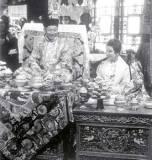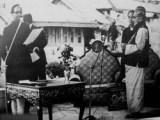Archives
Sikkim
Do we not as Sikkimese people deserve better understanding of our hopes and aspirations? Dr. Chamling asked while pointing out “After the merger, not a single cabinet berth has been allotted to Sikkim’s MPs and not a single Sikkimese has been appointed to any Constitutional post”.
 He also highlighted how Sikkim has redefined the concept of a border state. “We in Sikkim have successfully redefined the concept of a border state. Peace, communal harmony, security, growth and development are indicators of this. Our people are living a decent life free from insurgency and terrorism. We have proved that a border state can be equally or even more progressive and developed. This we have proved in actual terms thus making a great contribution towards advancing the cause of nation building”, said Dr. Chamling.
He also highlighted how Sikkim has redefined the concept of a border state. “We in Sikkim have successfully redefined the concept of a border state. Peace, communal harmony, security, growth and development are indicators of this. Our people are living a decent life free from insurgency and terrorism. We have proved that a border state can be equally or even more progressive and developed. This we have proved in actual terms thus making a great contribution towards advancing the cause of nation building”, said Dr. Chamling.
Meanwhile, Governor Mr. B. P. Sigh in his address on the occasion fully endorsed the Chief Minister’s call to the nation to insert Sikkim in the National Anthem substituting the word ‘Sindh’ “to promote a sense of emotional integration”. The Governor said, “The Chief Minister has formally, on this day, mentioned about ‘Sikkim’ to be made a part of the national anthem and I support it. We amended the preamble of the Constitution of India, almost at the same time when Sikkim decided to join the Republic of India, by adding the word ‘secularism’. So, this suggestion should be seen in that wide context by the Parliamentarians and national leadership,” the Governor said.
It may be recalled that the call to insert ‘Sikkim’ in place of ‘Sindh’ in the National Anthem had been earlier given by Dr. Chamling in a seminar on regional parties at Jamai Millia Islamia University at New Delhi on April 25th this year.
Why Sikkim observes state day?
 It was in 1975, when the Sikkimese people voted in a referendum to abolish monarchy & annexation by India, becoming its 22nd state. Friday, May 16,1975 marked the fulfillment of a quarter century long struggle of the people of this tiny Himalayan State to become master of their own affairs. It is on this day that Sikkim acquired the status of a full democracy by joining the political, economic and social mainstream of the Indian Union by giving up the three hundred old long feudal traditional monarchy. This day the Tricolour replaced the flag of the erstwhile Chogyal regime and
It was in 1975, when the Sikkimese people voted in a referendum to abolish monarchy & annexation by India, becoming its 22nd state. Friday, May 16,1975 marked the fulfillment of a quarter century long struggle of the people of this tiny Himalayan State to become master of their own affairs. It is on this day that Sikkim acquired the status of a full democracy by joining the political, economic and social mainstream of the Indian Union by giving up the three hundred old long feudal traditional monarchy. This day the Tricolour replaced the flag of the erstwhile Chogyal regime and
Mr . B.B. Lal took his oath of Office as the first Governor of the 22nd state of the Indian Union.
The most significant feature of the entire popular uprising was that the population, though constituted of various communities and language groups, stood as one to achieve their goal. Though the people’s struggle has been on since Indian Independence, it gained added momentum during the one-year struggle in 1975. Its culmination was the emergency sessions of the Sikkim Assembly on April 10th when it unanimously adopted the historic resolution for making Sikkim a full- fledged state of the Indian Union. And the referendum on the resolution on April 14th clearly showed what the people wanted. Overwhelmingly they voted in favor of the resolution.
On April 26th both houses of the Parliament passed the Constitutional Amendment taking Sikkim from an associate state to a full-fledged unit of the Indian Union. Eyewitnesses will vouch that these people had staged one of the most peaceful and non-violent revolutions unparalleled in world history.

The 32 member Assembly was constituted on the basis of elections held on April 15th adopted on June 20th Government of Sikkim Act, known as Sikkim’s Constitution, giving more powers to the elected house. It received Chogyal’s assent on July 3rd. July 23rd 1975 was another important day in the history of the state when the first popularly elected Government under the leadership of Mr .Kazi Lhendup Dorji Khangsarpa was installed.
The Union Cabinet at its meeting on August 30th approved the request of the Sikkim Government to provide representation to the state in both houses of Parliament. The public anger against the ruling dynasty was aggravated by Chogyal’s efforts to internationalize the Sikkim issue. His supporters protested to the United Nations Secretary General against India’s decision to give associate status to Sikkim. This was followed by a fast chain of developments moulding the history of this tiny state. The Chogyal visited Katmandu to attend King Birendra’s coronation without the approval of the Sikkim Cabinet making it clear that he did not recognize the Kazi Ministry. He also used this visit to propagate his idea of moving the International bodies to seek a ‘separate identity’ for Sikkim. This again was not approved by public opinion. The March 4th, 1975 incident at Rangpo in which Mr. R.C. Poudyal, MLA and General Secretary of the Sikkim Youth Congress was injured allegedly by erstwhile Sikkim Guards personnel sped up the developments that followed. On the request of the Sikkim Government the Government of India finally disbanded the Sikkim Guards on April 9th, 1975.
Anoop Rai

